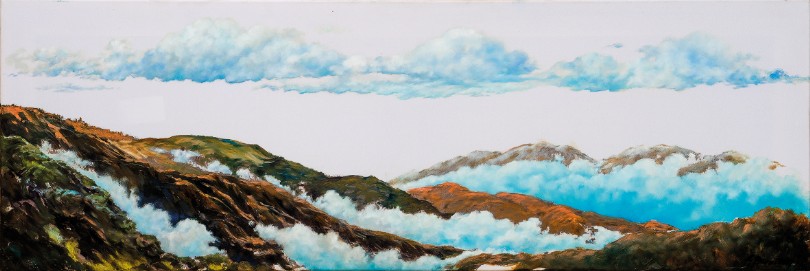CARMELO UCCHINO
Writer
The pictorial production of Giovanna Benzi is immediately expressed and fills the center of the field with some significant canvases and with a strong symbolic value (“Verso il mistero”, “Bagliore”, “Voglia di pioggia”, “L’ultima luce”, “In attesa”) that caress, with their dreamy, fantastic and dreamlike aura, vague gothic atmospheres of that Nordic Romanticism in which we find one of its greatest exponents in William Turner with all its charm of effects and halos. The chromatic and semantic scraps have expansions that range from a figure of average color to an intense brightness of clouds and skies depicted in decomposed magmatic spirals.
The explosions, however, are contained and never reach expressionistic outcomes. The canvases of Giovanna Benzi are expected to be seen but also “to be heard” above all in the sounds-non-sounds, almost like geysers, of passages of seasons and worlds expressed by a shapeless nature made of smoky masses and tangles, but strong, vague and indefinite. Nature traced without contours, between the visible and invisible light of its appearances, as in a magical world beyond, to immerse oneself in the shadows, in the shadows barely perceived but ready to wrap around us. The images are often fleeting and shapeless and, nevertheless, an almost floral and carnal happiness erupts suddenly and decides to overcome the power of white and black, the ancient diarchy and dichotomy of white and black, to beat paths that converge to colors of all kinds, which inhibit any attempt in giving the paintings a plastic order with a minimum sinuosity, sometimes outlined, but which never arrives to modeled and figurative solutions. Some paintings by Giovanna (“Explosion”, “Etna” “Le forme del vento”, “Avanzano”, “L’oro in cielo”) unfold and breathe softly in the gold and in the blue of vesper and crepuscular skies, leading us out of the darkness to migrate into rough areas of light where we can barely see ourselves for a short time. There is in the artworks of Giovanna Benzi, in their intimate and delicate expression, an inevitable dialectical tension between light and shadow, between day and night, between heaven and earth, between life and non-life. In the described landscapes there is no trace or footprint of a human on earth and when from the sky we touch the earth we meet only a couple of arboreal creatures that stretch out to speak with shreds of clouds and gashes of skies (like “Si parlano” and “L’albero verso il cielo”). In “Si accende” there is a whole front of trees, a whole group of vegetal beings that speak with a reddish sunset in part and also with a tuft of intense blue. There is not only the ecstatic, silent and absorbed contemplation of nature, but there is the word, the trees speak to us, they communicate their truth to us; despite the appearance of dumb simulacra, nature pulsates, we feel its heartbeats, we feel the breath of volcanoes. In the painting “Temporale in arrivo”, we share, more with the heart than with the mind, the fear of the impending storm. The trees are numb, unarmed, they fear the worst. Evermore the terrestrial front of the green is clinging and compact, looking at the united sky. Only in the oil “E’ solo”, a tree bends itself towards the sky like a missile, it rises solitary and imperious to conquer the cosmic spaces. And this is precisely the core of Giovanna Benzi’s Poetics: knowing how to combine and combine together the earthy attachment to the roots (even to the roots of the everyday little things) and a constant cosmic anxiety that forces her to look up at the stars. The paintings have the power to capture the eye and to nail it for a long time because, behind a good exercise of style, one can decipher artistic and cultural sedimentations that all belong to the artist’s experience, a background, her own, of which she is aware. and that, at the same time, manages to rework with original connotations. There is the training that is not only a job but there is also pictorial research, a vehicle for new messages and full of further developments.

